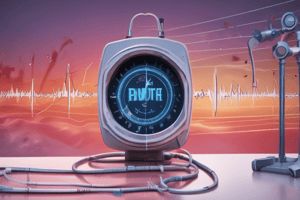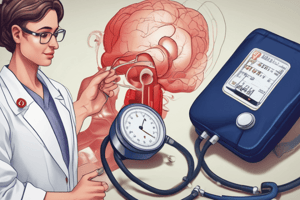Podcast
Questions and Answers
What is the correct position of the blood pressure cuff during measurement?
What is the correct position of the blood pressure cuff during measurement?
- At shoulder level, palm facing inward
- Below the elbow, palm facing down
- Above the wrist, palm up
- At heart level, palm up (correct)
Which of the following correctly describes the procedure for determining the maximum inflation level when taking blood pressure?
Which of the following correctly describes the procedure for determining the maximum inflation level when taking blood pressure?
- 30 points lower than the patient's age in years
- 30 points above the normal systolic level
- 30 points above the last audible Korotkoff sound
- 30 points beyond the radial pulse cessation level (correct)
What constitutes high blood pressure (hypertension) according to the given criteria?
What constitutes high blood pressure (hypertension) according to the given criteria?
- 140/90 or above (correct)
- 130/80
- 120/70
- 150/85
If a patient displays a blood pressure reading of 180/120, what immediate action should be taken?
If a patient displays a blood pressure reading of 180/120, what immediate action should be taken?
Which action is NOT recommended when diagnosing hypertension?
Which action is NOT recommended when diagnosing hypertension?
What is considered a normal average temperature for adults?
What is considered a normal average temperature for adults?
Which of the following factors can alter body temperature?
Which of the following factors can alter body temperature?
If a patient's temperature is measured at 105°F, what condition are they experiencing?
If a patient's temperature is measured at 105°F, what condition are they experiencing?
What temperature range indicates hypothermia?
What temperature range indicates hypothermia?
What should be done if a patient's vital signs are not within the normal range?
What should be done if a patient's vital signs are not within the normal range?
Which of the following conditions would likely cause an increase in respiration rate?
Which of the following conditions would likely cause an increase in respiration rate?
What is the normal respiration rate range for adults?
What is the normal respiration rate range for adults?
Which of the following would be considered bradypnea?
Which of the following would be considered bradypnea?
What is a common consequence of tachypnea in emergency situations?
What is a common consequence of tachypnea in emergency situations?
Which of the following best describes the quality of a pulse that is described as 'thready'?
Which of the following best describes the quality of a pulse that is described as 'thready'?
What is the typical heart rate range considered normal for adults?
What is the typical heart rate range considered normal for adults?
What might a decreased respiration rate indicate?
What might a decreased respiration rate indicate?
During a pulse examination, which rhythm describes beats that are consistently uneven?
During a pulse examination, which rhythm describes beats that are consistently uneven?
What is the term for an unusually slow heartbeat?
What is the term for an unusually slow heartbeat?
Which of the following factors is most likely to increase pulse rate?
Which of the following factors is most likely to increase pulse rate?
What is considered an abnormal pulse rate for adults?
What is considered an abnormal pulse rate for adults?
Which type of blood pressure is measured during ventricular contraction?
Which type of blood pressure is measured during ventricular contraction?
What is the factor affecting blood pressure not influenced by emotional states?
What is the factor affecting blood pressure not influenced by emotional states?
How should a patient’s arm be positioned when checking the radial pulse?
How should a patient’s arm be positioned when checking the radial pulse?
Which equipment is essential for measuring blood pressure accurately?
Which equipment is essential for measuring blood pressure accurately?
What effect does exercise have on blood pressure?
What effect does exercise have on blood pressure?
Flashcards are hidden until you start studying
Study Notes
Blood Pressure Measurement Procedure
- Position patient comfortably; arm at heart level and palm facing up.
- Locate the radial pulse and identify the maximum inflation level (30 mmHg above where pulse stops).
- Place stethoscope over the brachial artery for accurate sound detection.
- Gradually deflate the cuff; listen for the first and last Korotkoff sounds to determine systolic and diastolic pressures.
- Always confirm readings by repeating after a brief wait, documenting results in fraction format (e.g., 117/69).
Blood Pressure Cuff Sizing
- Proper cuff size is critical for accurate measurements; width should be ¼ wider than the arm circumference.
- Larger cuffs are required for obese or muscular individuals; pediatric cuffs are available for children.
Hypertension and Blood Pressure Guidelines
- Hypertension defined as blood pressure consistently above 140/90 mmHg.
- Associated health risks include cardiovascular disease, stroke, kidney failure, and premature death.
- Treatment referrals vary by stage: Lifestyle changes for Normal and Elevated; consult a primary care provider for Stage I; medical referrals for Stage II.
- Emergency care recommended for readings of 180/120 mmHg or higher; clinic cutoff at 170/100 mmHg.
Pulse Characteristics
- Tachycardia: heart rate over 100 beats per minute; requires investigation.
- Bradycardia: heart rate below 50 beats per minute; can signify underlying issues.
- Factors increasing pulse: exercise, stimulants, emotional disturbances; decreasing factors include sleep and depressants.
Blood Pressure Fundamentals
- Blood pressure defined as the force exerted by blood on arterial walls.
- Systolic pressure (highest) occurs during heart contraction; diastolic pressure (lowest) occurs during relaxation.
- Pulse pressure calculated as the difference between systolic and diastolic pressures.
- Influencing factors: heartbeat force, peripheral resistance from vessel elasticity, and total blood volume.
Vital Signs Overview
- Essential for systemic evaluation and influence on dental treatment and planning.
- Patient should be seated upright and consent obtained prior to measurements.
Normal Body Temperature Ranges
- Average temperature for adults: 98.6°F; normal range is 97°F to 99°F.
- Older adults typically have a slightly lower average of 96.8°F.
- Children’s temperature varies by age, peaking at 99.4°F in the fourth year.
Temperature Variations and Influencing Factors
- Fever considered as temperature exceeding 99.5°F; hyperthermia over 104°F; hypothermia below 96°F.
- Body temperature affected by time of day, physical state (infections or trauma), and environmental factors.
Respiratory Assessment
- Normal adult respiratory rate ranges from 12 to 20 breaths per minute; higher for women.
- Children’s rates decrease over time; older adults show higher predictive value for complications.
- Tachypnea defined as a rate over 28 breaths per minute; bradypnea under 12 breaths.
Assessing Respiration
- Count chest rises for 30 seconds and multiply by two for rate.
- Note depth (shallow to deep), rhythm (regular to irregular), and quality (strong to labored).
- Document abnormal respiratory sounds during inspiration or expiration.
Pulse and Heart Rate Monitoring
- Adult resting pulse typically ranges from 60 to 100 beats per minute; varies with individual factors.
- Observe rhythm (regular or irregular) and strength (full or weak) while counting pulse.
- Children’s heart rate trends downward during childhood; closer observation for irregularities is essential.
Studying That Suits You
Use AI to generate personalized quizzes and flashcards to suit your learning preferences.




